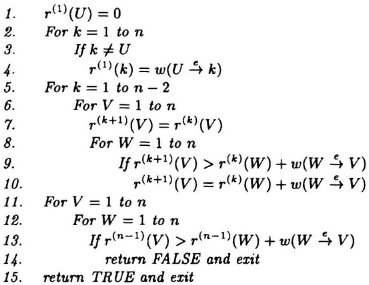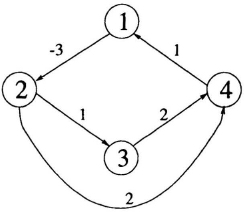A.2 THE BELLMAN-FORD ALGORITHM
The Bellman-Ford algorithm is a single-point shortest path algorithm. If no negative cycles exist in the graph, it finds the shortest path from an arbitrarily chosen node U (called the origin) to each node in the graph. For a graph with n nodes, the algorithm constructs n − 1 vectors r(k), k = 1, 2, … , n − 1, which are each of size n × 1, as described in Figure A.2. Note that r(k) (U) represents the U-th entry in the column vector r(k).

Fig. A.2 The Bellman-Ford algorithm.

Fig. A.3 A graph containing no negative cycles.
If TRUE is returned, then r(n−1)(V) is SUV , which is the shortest path from the node U to the node V. If FALSE is returned, then the graph contains at least one negative cycle.
Example A.2.1 In this example, the Bellman-Ford algorithm in Figure A.2 is used to find the shortest path from the node U = 2 to the nodes in the graph in Figure A.3. The values of r(k)(V) for k = 1, 2, 3 and V = 1, 2, 3, 4 are shown in Table A.1. The Bellman-Ford algorithm returns TRUE in this example, so the value of r(3)(V) is the shortest path from node 2 to node V for V = 1, 2, 3, 4. ![]()
Table A.1 Values of r(k)(V) for k = 1, 2, 3 and V = 1, 2, ...
Get VLSI Digital Signal Processing Systems: Design and Implementation now with the O’Reilly learning platform.
O’Reilly members experience books, live events, courses curated by job role, and more from O’Reilly and nearly 200 top publishers.

